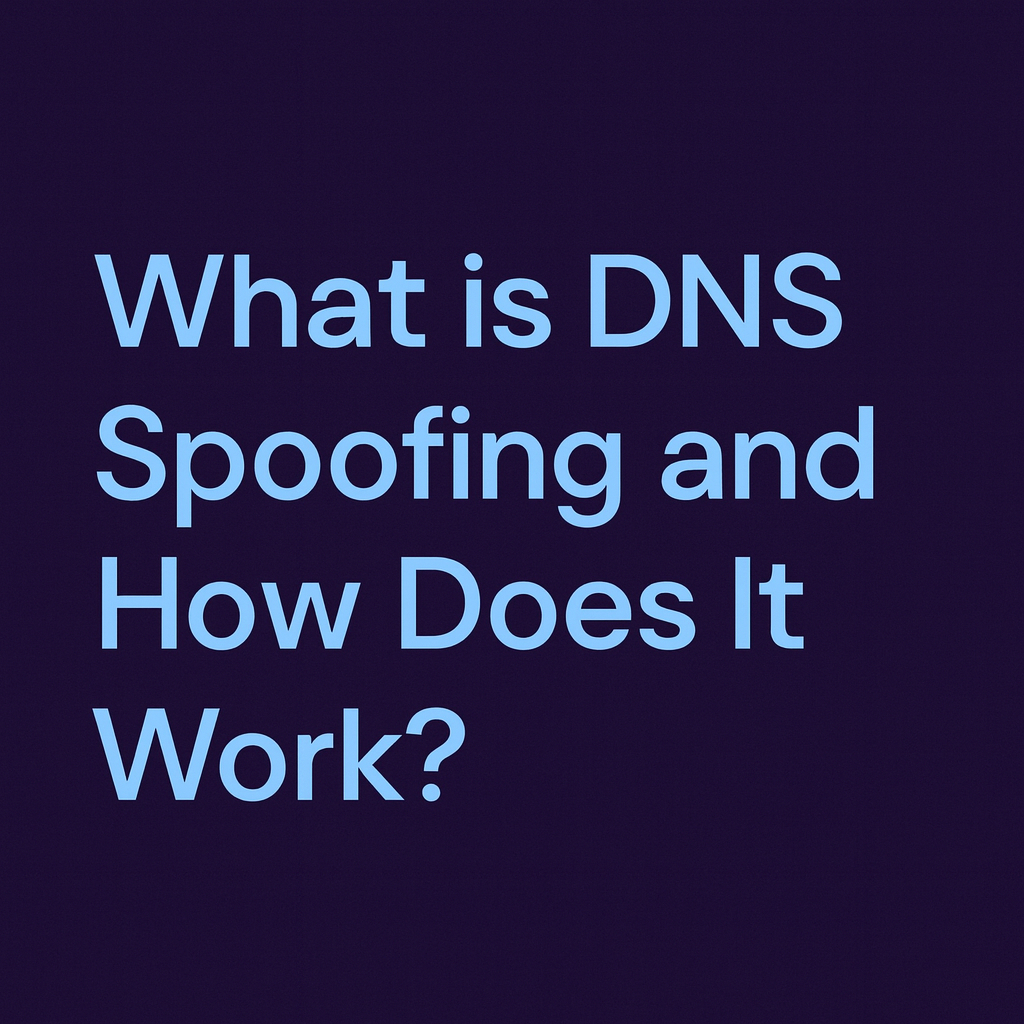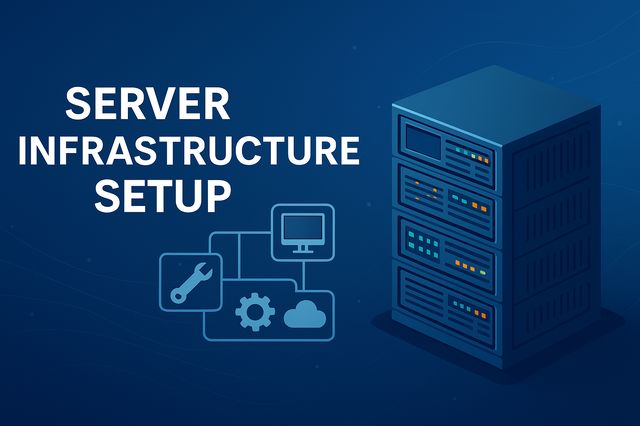DNS spoofing attacks in 2025 exploit weaknesses in the Domain Name System to redirect users to malicious sites without their knowledge.
For SMBs, these cache poisoning and rogue DNS tactics can lead to credential theft, ransomware, and data breaches.
Defending against them requires DNSSEC, encrypted DNS (DoH/DoT), and continuous DNS monitoring turning basic network hygiene into a cornerstone of modern cybersecurity.
What Is DNS Spoofing and Why It Matters in 2025

Every time you type a website address from office.com to your online banking page your device asks a DNS (Domain Name System) server for directions.
DNS works like the internet’s phone book, translating domain names into IP addresses so browsers know where to connect.
In a DNS spoofing attack (also called DNS cache poisoning), a cybercriminal tampers with this process. Instead of receiving the correct IP address, users are silently redirected to a fake website that looks legitimate but exists solely to steal data or install malware.
Attackers exploit vulnerabilities in DNS servers, routers, or endpoint configurations to insert malicious DNS entries into local caches. Once poisoned, every device that queries that server will be misdirected potentially exposing entire businesses.
Why It Matters
While enterprises often deploy layered DNS security, SMBs (Small and Medium Businesses) remain highly exposed.
They rely on unmanaged routers or ISP-provided DNS servers.They lack visibility into DNS queries.They rarely monitor for tampering or spoofing indicators.
In Proofpoint’s threat research, DNS-based attacks were found to increase year-over-year, often serving as the first stage of credential theft or ransomware delivery. DNS spoofing remains effective because it abuses a protocol that most businesses take for granted.
How DNS Spoofing Works | Inside the Attack Chain
DNS spoofing manipulates the trust model between clients and DNS servers. The attacker’s goal: inject false data into the DNS cache before the legitimate answer arrives.
Cache Poisoning
Attackers send forged DNS responses faster than legitimate ones, tricking the resolver into caching the wrong IP address. Future queries then route traffic to a malicious site.
Rogue DNS Servers
In some cases, a router or device is compromised, and its DNS settings are altered to use a rogue DNS server controlled by the attacker.
Man-in-the-Middle Manipulation
By intercepting DNS requests over unsecured Wi-Fi or internal networks, attackers inject spoofed replies, rerouting users without changing local configurations.
DNS Hijacking via Firewalls
Outdated firmware or default passwords in SMB routers make them a favorite target. Once hijacked, every device connected to that router resolves domains through malicious DNS servers.
Once poisoned, the results are immediate users believe they are on the legitimate site (often with a fake padlock or HTTPS indicator) and willingly enter credentials, credit card numbers, or download malware-laden “updates.”
The Hidden Impact | Why SMBs Get Caught Off-Guard
For small and mid-sized organizations, DNS spoofing isn’t an exotic cyber threat it’s a silent business risk.
Weak Perimeter Equipment
Many SMBs still depend on consumer-grade routers or outdated firewalls without DNS inspection. Attackers exploit these to reconfigure DNS settings remotely.
Lack of DNS Monitoring
Most small IT teams never log DNS requests or inspect anomalies. As Imperva notes, this “blind spot” allows spoofed domains to operate undetected for weeks.
No DNSSEC Enforcement
Few SMBs enable DNSSEC a cryptographic signature system that verifies domain authenticity. Without it, browsers can’t tell genuine responses from forged ones.
Reliance on ISP DNS
Using default DNS servers from internet providers may seem harmless, but those servers rarely offer threat filtering or encryption.
Business Consequences
When users reach phishing sites that imitate Microsoft 365, PayPal, or internal portals, credentials are stolen and used for business email compromise (BEC) or ransomware infiltration.
Proofpoint reports that DNS hijacking was involved in nearly 30% of phishing-related incidents targeting small firms in 2024.
Real-World DNS Spoofing Scenarios

Compromised Office Router
An SMB in Europe had its router firmware exploited. Attackers redirected all traffic from outlook.office.com to a phishing clone. Employees logged in normally unaware they were entering passwords into a fake portal. Within hours, attackers used those accounts to send internal phishing emails, expanding their foothold.
Local Cache Poisoning
A single infected laptop poisoned the DNS cache on a local Windows server. As a result, every employee connecting to vpn.company.com was routed to a malicious IP that collected credentials through a cloned login page.
Rogue Wi-Fi Access Point
In a co-working environment, a rogue access point broadcasted an identical SSID. Devices connected automatically, and DNS queries were intercepted and spoofed. Sensitive data and authentication cookies were stolen before detection.
These examples show the real cost of DNS manipulation: lost trust, leaked data, and network compromise all starting from a single poisoned record.
Detecting DNS Spoofing Before It Spreads
Detection often requires awareness of subtle changes. SMBs should implement both automated and manual checks.
Indicators of DNS Spoofing
Redirects to unfamiliar websites
SSL certificate mismatch warnings
IP address differences for the same domain on different devices
DNS queries returning inconsistent results
Sudden spikes in DNS traffic volumes
Tools and Practices
Use DNS logging within firewalls and Windows servers.
Compare responses using public resolvers (Cloudflare 1.1.1.1, Google 8.8.8.8).
Deploy security tools like Heimdal DNS Security or Cisco Umbrella for anomaly detection.
Integrate DNS monitoring with SIEM platforms such as Microsoft Sentinel or Splunk.
Defense Framework | Proven DNS Security Measures
Mitigation requires layered controls not just one fix. The most effective defenses combine secure configuration, encryption, and external intelligence.
DNSSEC (Domain Name System Security Extensions)
Digitally signs DNS records to verify authenticity. If a record is altered, browsers reject it. Imperva emphasizes that DNSSEC is one of the most effective ways to prevent cache poisoning.
DNS over HTTPS (DoH) and DNS over TLS (DoT)
Encrypts DNS traffic so attackers can’t intercept or modify queries in transit. These protocols protect endpoints from man-in-the-middle manipulation.
Managed DNS Filtering
Use providers like Cloudflare for Teams, Quad9, or Cisco Umbrella that maintain updated threat intelligence and automatically block known malicious domains.
Firewall-Level DNS Inspection
Business firewalls (Fortinet, Sophos, WatchGuard, Cisco Meraki) can inspect DNS traffic and block suspicious requests at the perimeter.
Enable features such as:
DNS over TLS enforcement
DNS reputation lookups
Anomaly alerts for external resolvers
Endpoint Detection and Response (EDR)
Modern EDR platforms like Bitdefender GravityZone and SentinelOne extend protection to network layers, detecting suspicious DNS patterns and blocking communication with known malicious IPs.
Regular Firmware & Patch Management
Unpatched routers and switches are often the weakest link. SMBs should update firmware quarterly and change default DNS admin credentials.
Step-by-Step SMB Implementation Plan
Here’s a practical roadmap any SMB can follow without deep technical expertise:
Audit Your DNS Infrastructure
List all devices resolving DNS (servers, routers, endpoints). Identify who manages each.
Switch to a Secure DNS Provider
Use managed services like Cloudflare (1.1.1.1 for Business) or Quad9 (9.9.9.9) with filtering.
Enable DNSSEC and Encryption
Request DNSSEC from your domain registrar and configure DNS over HTTPS on all endpoints.
Lock Down Router Access
Change default passwords, restrict remote admin access, and enable automatic firmware updates.
Monitor DNS Logs
Review DNS queries monthly; look for domains with unfamiliar TLDs or sudden spikes.
Integrate Alerts with Security Tools
Use your SIEM or EDR to flag abnormal DNS resolutions.
Educate Employees
Train staff to recognize browser certificate warnings or suspicious redirects.
Perform Annual DNS Security Reviews
Include DNS hygiene in your yearly security assessment.
This structured plan helps even small teams gain DNS visibility and resilience against spoofing attempts.
Best Practices and Long-Term Maintenance
Long-term defense requires both technology and policy.
Limit DNS Admin Privileges: Only authorized IT personnel should modify DNS settings.
Document and Review Changes: Keep a DNS change log; unauthorized edits are a red flag.
Segment Networks: Isolate guest Wi-Fi from internal DNS.
Use Multi-Layer Validation: Combine DNSSEC with SSL certificate pinning for high-trust applications.
Test Failover Scenarios: Verify that backup DNS servers are equally secure.
As Heimdal highlights, DNS protection is not a one-time project it’s a continuous process of validation, monitoring, and education.
The Future of DNS Security
Looking ahead, DNS spoofing is evolving. Attackers now automate domain impersonation using AI-driven phishing kits and exploit DNS visibility gaps introduced by encrypted DNS protocols.
Emerging Challenges
AI-Generated Domains: Attackers use generative models to create convincing look-alike domains.
IoT Devices: Millions of connected devices rely on hardcoded DNS settings, often unsecured.
Privacy vs. Visibility: While DNS over HTTPS improves privacy, it also hides DNS traffic from corporate monitoring tools creating new detection blind spots.
The Next Phase for SMBs
Adopt zero-trust DNS policies.
Consolidate DNS management under centralized, monitored systems.
Combine automation with human oversight using tools that both encrypt and inspect traffic intelligently.
Conclusion
DNS spoofing is not an abstract cyber risk it’s a real, recurring threat that thrives on neglect.
For SMBs, the cost of inaction is steep: hijacked credentials, customer data loss, and damaged brand trust.
But the solution doesn’t require a full-scale SOC. With the right DNS security policies, managed services, and routine monitoring, even a small IT team can close this attack vector permanently.
Run a DNS configuration audit.
Move to a trusted DNS provider.
Enable DNSSEC and encrypted DNS today.
Because the weakest link in your cybersecurity stack shouldn’t be the one that tells your users where to go.

DNS spoofing, also called DNS cache poisoning, occurs when attackers inject false DNS records into a resolver’s cache.
This redirects users to fake websites that mimic legitimate ones, often used for credential theft, malware delivery, or phishing.
SMBs often rely on default ISP DNS servers or outdated routers without inspection, logging, or encryption.
Without DNSSEC or managed DNS filtering, attackers can manipulate traffic silently compromising users before detection.
Unexpected redirects or SSL certificate warnings
Different IP results for the same domain across devices
DNS queries returning inconsistent or suspicious domains
Spikes in DNS traffic or anomalies in logs
Tools like Cloudflare (1.1.1.1), Heimdal DNS Security, or Cisco Umbrella can help verify legitimate responses.
DNSSEC: Digitally signs DNS records for authenticity.
DNS over HTTPS (DoH) and DNS over TLS (DoT): Encrypt DNS queries to block interception.
Managed DNS Filtering: Blocks known malicious domains.
Firewall DNS Inspection: Monitors DNS traffic for anomalies.
EDR Integration: Detects suspicious DNS patterns on endpoints.
Use a trusted provider (Cloudflare, Quad9, or Cisco Umbrella).
Enable DNSSEC with your registrar.
Lock router admin access and update firmware.
Monitor DNS logs monthly.
Educate staff to recognize spoofed redirects or SSL errors.
Even small IT teams can secure DNS by combining encryption, visibility, and training.
Future threats include AI-generated domains, IoT device exploitation, and visibility loss due to encrypted DNS traffic.
The next phase of protection will focus on zero-trust DNS policies, centralized monitoring, and AI-driven anomaly detection that balances privacy with visibility.
References
What is DNS cache poisoning? | DNS spoofing – CloudeFlare
DNS Poisoning (DNS Spoofing): Definition, Technique & Defense – OKTA
What is DNS Poisoning: A Cybersecurity Guide to DNS Spoofing and Cache Attacks – huntress
What Is DNS Poisoning? – FORTINET


